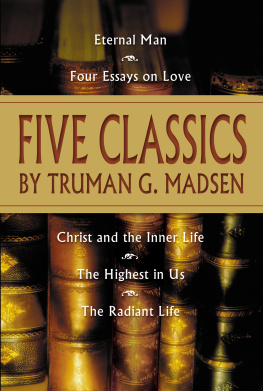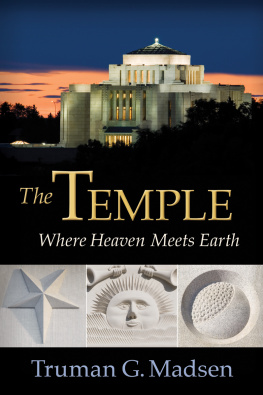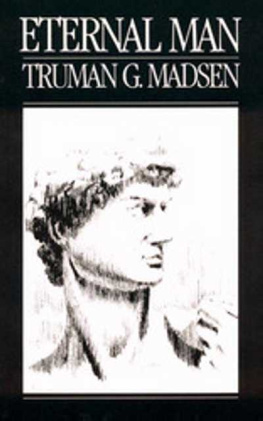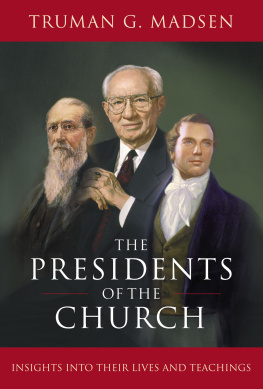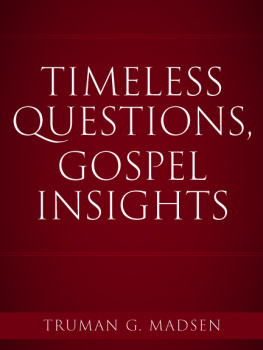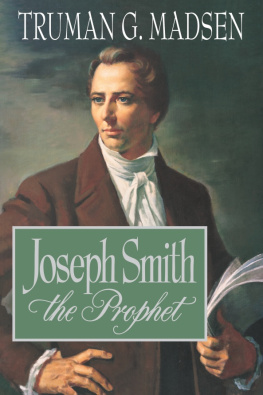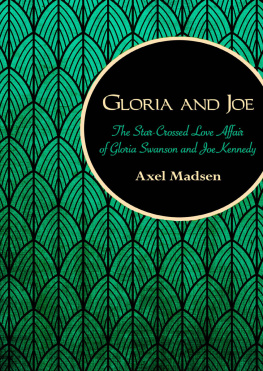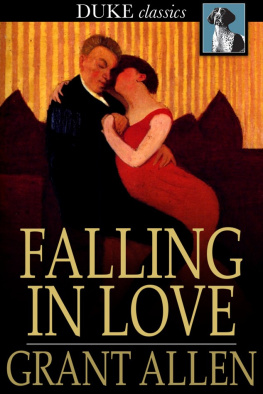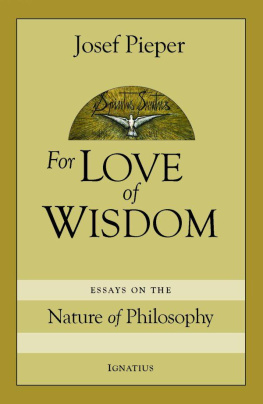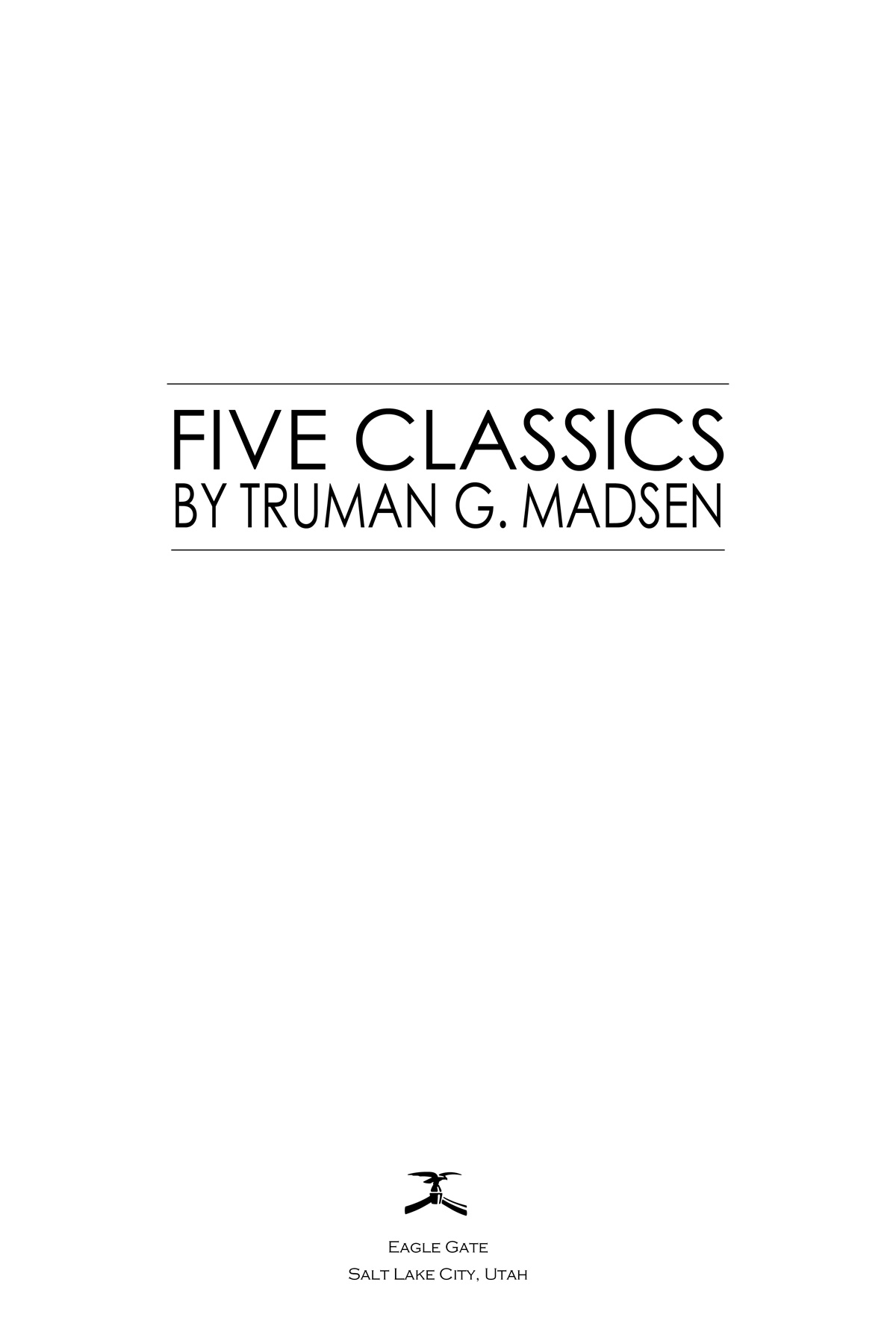2001 Truman G. Madsen.
All rights reserved. No part of this book may be reproduced in any form or by any means without permission in writing from the publisher, Deseret Book Company, P.O. Box 30178, Salt Lake City Utah 30178. This work is not an official publication of The Church of Jesus Christ of Latter-day Saints. The views expressed herein are the responsibility of the author and do not necessarily represent the position of the Church or of Deseret Book. Deseret Book is a registered trademark of Deseret Book Company.
Eagle Gate is a registered trademark of Deseret Book Company.
Visit us at www.deseretbook.com
Library of Congress Control Number: 2001093359
ISBN 1-57008-720-2
Printed in the United States of America 72082-6856
10 9 8 7 6 5 4 3 2 1
Publishers Preface
Truman Madsen is a man of great faith, broad learning, and compelling intellectual power. But it is his distinctive and illuminating vision, his great gift for seeing patterns of the Gospel everywhere, that makes his work so uniquely memorable. He sees the God-given design in our lives and our environment, and seeing that design, he can embody heavenly ideas, concepts, and principles in the solid stuff of everyday life. Truman helps us to see that Christ is central to all things, and that truly all things... are a typifying of Him (2 Nephi 11:4). Thus through Trumans explanations we are led to more than intellectual comprehension; we come to see and feelto recognizein such a way that we can experience Christs influence in all the world around us. And because we see the seeds and trees, because we feel the weight and pressure of the olive press in the context of the Gospel, we come to better appreciate and know the meaning of Gethsemane and Calvary and the empty tomb.
To put it another way, Truman may have the intellect of a genius but he also has the sensitivity of a poet. Consider for example how he joins images of water and currents to help us understand an important principle in this following passage (chosen from the pages of this collection). He says, speaking of certain continuing doctrines, I can bear you a testimony that these currents and many more are part of the flowing fountain of the Church. If we do not drink, if we die of thirst while only inches from the fountain, the fault comes down to us. For the free, full, flowing, living water is there.
In Trumans metaphors we not only recognize allusions to Christs self-identification with the living water (John 4:714), we also see that life-giving stream as part and parcel of the Church itself. Furthermore, we hear in Trumans syllables a concern for the sounds of the words themselves; the very enunciation (free, full, flowing, and so on) effectively emphasizing and connecting the adjectives together for the ear as well as the eye in a beautiful representation of the qualities of that divine water. These are not mere rhetorical flourishes. Trumans love of words ultimately derives from his obvious love of Him whom John refers to as The Word.
Finally there is an unusual sincerity in these essays reflecting qualities of the author himself. Truman not only writes from a deep level of his own belief, he strives to live the principles he talks about; one recognizes the exhortations of these pages in the behavior of the man. To shake hands with Truman is to be pulled into the warm circle of his love. To travel with him is to see his concern for the least among you. I remember, for instance, his careful, thoughtful, kindly support of an eighty-year-old travel-weary tourist up the uneven steps of Old Jerusalem, making sure that she too, in the last years of her life, could walk today where Jesus walked.
As he cared for this silver-haired lady so he cares for his students. Though tall in stature, Truman never stands above his class nor his audience. He is one with his students, rejoicing with them in their coming to understand and know, as all are edified together (D&C 50:2224). His sensitivity to all those who seek and strive to learn extends far beyond the lecture hall. Consider, for instance, one very small but telling example: a young family with seven children recently moved into the ward where Truman Madsen is a Gospel Doctrine teacher for the Sunday School. On the first Sunday there, the mothertired and a bit frazzled by the chaotic challenge of unpacked boxes and trying to help the family find and unwrinkle Sunday clothes and get ready and get to the churchfinally got her little brood settled into their respective Sunday School classes. She then slipped as quietly as possible into the back row of the already-in-progress Gospel Doctrine class. But her coming to Sunday School did not go unnoticed. Back home after church, she was surprised when, responding to a knock at her front door, she saw the teacher standing on her front porch. Truman had come to her door to welcome her into the ward. He saw her effort and presence in class that day as a compliment and thanked her for coming to Sunday School.
So it is with these pages. If we feel the welcoming presence of a genuine Christian, it is because of the true effort and the true faith of this true man. In what follows we are, indeed, well-taught. We have before us not just inspiring instruction, but an inspiring individual who loves the Savior. We are indeed fortunate in having these essays so attractively and conveniently brought forward again in this collection.
Neal Lambert
Professor Emeritus
Brigham Young University
Eternal Man
Preface
Sometimes during solitude I hear truth spoken with clarity and freshness; uncolored and untranslated it speaks from within myself in a language original but inarticulate, heard only with the soul, and I realize I brought it with me, was never taught it nor can I efficiently teach it to another.
President Hugh B. Brown
The story behind these essays is still a matter of wonder in me. To a topic and titleWhence Cometh Man???The Instructor editors added a hope. It has been suggested, their letter said, that you explain the meaning of premortality for some of the ultimate issues of human existence. Their intent was that I sketch in outline form the singular Mormon theme of preexistence on the canvas of present-day philosophical approaches to man. So the effort was made.
The response was, to me at least, quite unforeseen. Not just teachers, whom we had expected to nudge toward wider application of their topics, but a variety of persons wrote for sources and further comparisons. Soon the editors asked that this article be the introduction to six others, around the issues barely broached within it: personal identity, creation, embodiment, freedom, suffering, and self-awareness. The query followed: Will these be published in book form? Till now I have answered, No, convinced that interest would diminish. Instead it has increased.
Here, then, is the series, written as a kind of midrash, a commentary on a theme. It can justly be said that they are not more than this, but not, I hope, that they are less. Letters of praise for their objectivity (which usually means that I have named and highlighted some of the live alternatives) miss my feeling that such merit as they have is in their subjectivity. Their primary gesture is toward inner echoes, toward, as it were, the nerve endings of the spirit. For this reason, likewise, I am surprised at comments which assume I have proved or refuted this or that. The goal has been to clarify rather than to verify, with little room for argument, except an implicit appeal to introspection.

